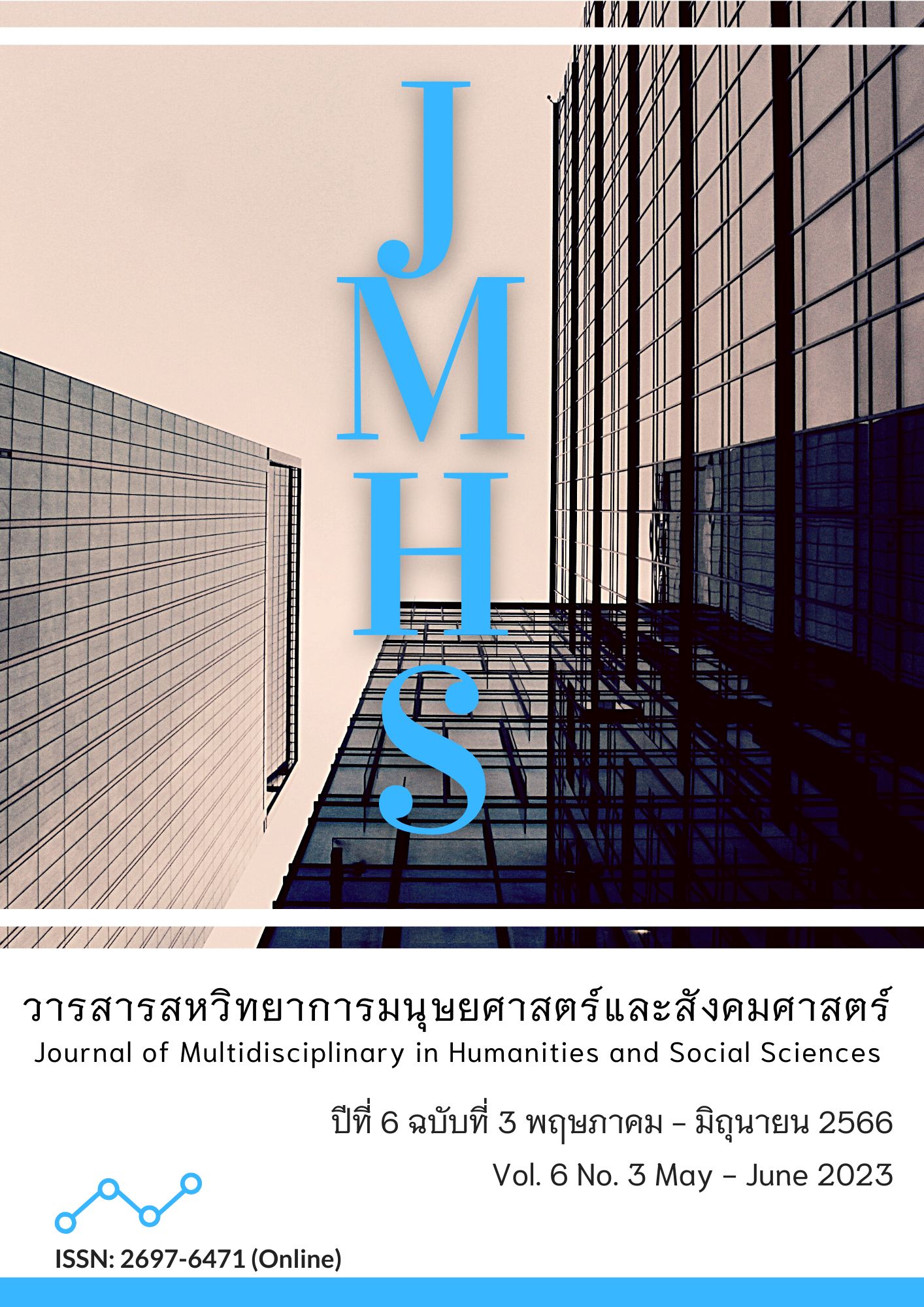Causal Factors Influencing Purchase Intention Safe Water Filter via Shopee Application in Bangkok and Its Vicinity
Main Article Content
Abstract
The article aimed to 1) develop and validate a causal relationship model of purchase intention for safe water filters via the Shopee application in Bangkok and its vicinity, and 2) inquire into the causes and causal factors influencing purchase intention for safe water filters via the Shopee application in Bangkok and its vicinity. This study was quantitative research. The sample consisted of people who had bought safe water filters via the Shopee application and lived in Bangkok and its vicinity of 400 people by convenience sampling. The tools used in the research were online questionnaires. The statistics used in data analysis were frequency, percentage, confirmatory factor analysis, and the structural equation model.
The results of this research were the development of causal relationship models consisting of 4 components: 1) brand image; 2) celebrity endorser; 3) trust; and 4) purchase intention. The model was consistent with the empirical data to a great extent. The statistics showed CMIN/df = 1.95, GFI = 0.93, AGFI = 0.91, SRMR = 0.03, and RMSEA = 0.05. The final predictive coefficient was 0.81, indicating that the variables in the model can explain the variance of the purchase intention of a safe water filter by 81 percent. It was found that trust, brand image, and celebrity endorsers had respective influences on purchase intention. The safe water filter production company should consider the trust of customers because it creates trust for consumers and can be used to promote sales.
Article Details

This work is licensed under a Creative Commons Attribution-NonCommercial-NoDerivatives 4.0 International License.
Views and opinions appearing in the Journal it is the responsibility of the author of the article, and does not constitute the view and responsibility of the editorial team.
References
การศึกษา ฟิวเจอร์ ช้อปเปอร์. (2565) Wunderman Thompson's 'The Future Shopper Report 2022. สืบค้นเมื่อ 1 กุมภาพันธ์ 2566, จาก https://www.wundermanthompson.com/insight/the-future-shopper-2022.
ปณิชามน ตระกูลสม. (2562). ผลการใช้บุคคลที่มีชื่อเสียงรับรองเครื่องสำอางต่อความตั้งใจซื้อสินค้า.วารสารนิเทศศาสตร์, 37(3), 10-19. สืบค้นจาก https://so02.tci-thaijo.org/index.php/jcomm/article/view/226679
ชนิตา กิมเต็ก และ สุมามาลย์ ปานคํา. (2561). โมเดลความสัมพันธ์เชิงสาเหตุความตั้งใจซื้อสินค้าผ่านทวิตเตอร์ของประชากรในเขตกรุงเทพมหานครและปริมณฑล. การประชุมวิชาการระดับชาติ ครั้งที่ 13 เรื่อง เปลี่ยนผ่านอย่างสร้างสรรค์สู่ศตวรรษที่ 21. วันที่ 29 มีนาคม 2561 (น. 1256-1268). ปทุมธานี: มหาวิทยาลัยธุรกิจบัณฑิต.
ณัฐชานันท์ นพคุณนิรันดร. (2560). ภาพลักษณ์ธนาคารอิสลามแห่งประเทศไทยในสังกัดสำนักงานภาคใต้ตอนบน ตามการรับรู้ของผู้ใช้บริการ. วารสารศิลปการจัดการ, 28(1), 80-97. สืบค้นจาก https://so03.tci-thaijo.org/index.php/msj/article/view/116490
ธีรศักดิ์ จินดาบถ, สุนันทา เหมทานนท์, และ พิไลวรรณ ประพฤติ. (2561). การรับรู้คุณค่าและความตั้งใจซื้อผลิตภัณฑ์ยางของผู้บริโภคชาวไทย. วารสารบริหารธุรกิจศรีนครินทรวิโรฒ. 9(2),106-11. สืบค้นจาก https://so02.tci-thaijo.org/index.php/jam/article/view/248325
สมชาย เล็กเจริญ, และ ชัญญา นุตตะไลย์. (2565). ปัจจัยเชิงสาเหตุที่มีอิทธิพลต่อความตั้งใจซื้อบัตรคอนเสิร์ตบนแอปพลิเคชันทิดเก็ตเมล่อนของผู้บริโภคในเขตกรุงเทพมหานครและปริมณฑล. วารสารบัณฑิตศาส์น, มหาวิทยาลัยมหามกุฏราชวิทยาลัย, 20(1), 15-24. สืบค้นจาก https://so04.tci-thaijo.org/index.php/mgsj/article/view/259974
สำนักงานพัฒนาธุรกรรมทางอิเล็กทรอนิกส์. (2564, 10 มิถุนายน). e-Commerce ไทย ยุคหลัง COVID-19. สืบค้นเมื่อ 17 ตุลาคม 2565, จาก https://www.etda.or.th/th/Useful-Resource/Knowledge-Sharing/Perspective-on-Future-of-e-Commerce.aspx
สำนักงานพัฒนาธุรกรรมทางอิเล็กทรอนิกส์. (2565, 21 สิงหาคม). รายงานผลการสำรวจพฤติกรรมผู้ใช้อินเทอร์เน็ตอินเทอร์เน็ตในประเทศไทย ปี2565. สืบค้นเมื่อ 9 กุมภาพันธ์ 2566, จาก https://www.etda.or.th/getattachment/78750426-4a58-4c36-85d3-d1c11c3db1f3/IUB-65-Final.pdf.aspx
สิริชัย ดีเลิศ. (2560). การใช้สื่อสังคมออนไลน์อินสตาแกรมเพื่อสร้างความสำเร็จในการรับรู้ภาพลักษณ์ตราสินค้าของธุรกิจ. Veridian E-Journal,Silpakorn University, 10(1), 1422-1438. สืบค้นจาก https://he02.tci-thaijo.org/index.php/Veridian-E-Journal/article/view/89246
สุนันทา เหมทานนท์ และ พิไลวรรณ ประพฤติ. (2561). การรับรู้คุณค่าและความตั้งใจซื้อผลิตภัณฑ์ยางของผู้บริโภคชาวไทย. วารสารบริหารธุรกิจศรีนครินทรวิโรฒ, 9(2), 106-116. สืบค้นจาก https://so02.tci-thaijo.org/index.php/jam/article/view/248325
สุมามาลย์ ปานคำ, และ วรณัน จันทรอด. (2565). ปัจจัยเชิงสาเหตุที่มีอิทธิพลต่อความตั้งใจใช้บริการพนักงานทำความสะอาดบนแอปพลิเคชันซีคสเตอร์ในกรุงเทพมหานครและปริมณฑล. วารสารศิลปการจัดการ, 6(3), 1096-1114. สืบค้นจาก https://so02.tci-thaijo.org/index.php/jam/article/view/256192
หิรัญ หิรัญประทีป และ รวิพรรณ สุภาวรรณ. (2559). ภาพลักษณ์และทัศนคติที่ส่งผลต่อการตั้งใจซื้อเครื่องสำอางในร้าน Drugstore ในเขตกรุงเทพมหานคร. ใน การประชุมวิชาการระดับชาติ ครั้งที่ 1 มหาวิทยาลัยเกษตรศาสตร์ วิทยาเขตศรีราชา: การวิจัยเพื่อพัฒนาอย่างยั่งยืน วันที่ 29 สิงหาคม 2559 (น. 122-127). ชลบุรี: มหาวิทยาลัยเกษตรศาสตร์ วิทยาเขตศรีราชา.
อานุมาต มะหมัด และ พีรภาว์ ทวีสุข. (2561). ภาพลักษณ์ตราสินค้าที่มีอิทธิพลต่อกระบวนการตัดสินใจซื้อผลิตภัณฑ์อาหารแปรรูปประเภทไส้กรอกในร้านสะดวกซื้อ. วารสารสุทธิปริทัศน์, 32(103), 132-147. สืบค้นจาก https://so05.tci-thaijo.org/index.php/DPUSuthiparithatJournal/article/view/243599
Hair, J. F., Black, W. C., Babin, B. J., & Anderson, R. E. (2010). Multivariate Data Analysis (7th ed.). Upper Saddle River, NJ: Prentice Hall.
Hair, J. F., Hult, G. T. M., Ringle, C. M., & Sarstedt, M. (2014). A Primer on Partial Least Squares Structural Equation Modeling (PLS-SEM). California, CA: Sage Publications.
Herjanto, H. (2019). University of the Incarnate Word, United States of America. Organizations and Markets in Emerging Economies, 11(1), 203–221.
Hoelter, J. W. (1983). The Effects of Role Evaluation and Commitment on Identity Salience. Social Psychology Quarterly, 46(2), 140–147. Retrieved from https://doi.org/10.2307/3033850
Hu, L.T., & Bentler, P. M. (1999). Cutoff Criteria for Fit Indexes in Covariance Structure Analysis: Conventional Criteria Versus New Alternatives. Structural Equation Modeling, 6(1), 1–55. Retrieved from https://doi.org/10.1080/10705519909540118
Imhmed, M.A.S., Azizan, N.B., & Jali, M.Z. (2013). The Impact of Trust and Past Experience on Intention to Purchase in E-Commerce. International Journal of Engineering Research and Development, 7(10).
Joreskog, K. G., & Sorbom, D. (1984). Advances in Factor Analysis and Structural Equation Models. Lanham: Rowman & Littlefield Publishers.
Kline, R.B. (2011). Principles and Practices of Structural Equation Modeling (3rd ed.). New York The Guilford Press.
Morgan, R.M., & Hunt, S.D. (1994) The Commitment-Trust Theory of Relationship Marketing. Journal of Marketing, 58, 20-38. http://dx.doi.org/10.2307/1252308
Schreiber, J.B., Stage, F.K., King, J., Nora, A., & Barlow, E.A. (2006). Reporting Structural Equation Modeling and Confirmatory Factor Analysis Results: A Review. The Journal of Educational Research, 99(6), 323–337. Retrieved from https://doi.org/10.3200/JOER.99.6.323-338
Schumacker, R.E., & Lomax, R.G. (2004). A Beginner's Guide to Structural Equation Modeling (2nd ed.). Lawrence Erlbaum Associates Publishers.
Thompson, B. (2004). Exploratory and Confirmatory Factor Analysis: Understanding Concepts and Applications. American Psychological Association. Retrieved from https://doi.org/10.1037/10694-000
Ullman, M.T. (2001). The Declarative/Procedural Model of Lexicon and Grammar. Journal of Psycholinguistic Research, 30(1), 37–69. Retrieved from https://doi.org/10.1023/A:1005204207369


